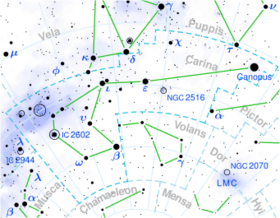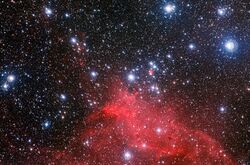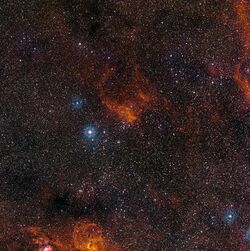Astronomy:V533 Carinae
| Observation data Equinox J2000.0]] (ICRS) | |
|---|---|
| Constellation | Carina |
| Right ascension | 11h 12m 36.01358s[1] |
| Declination | −60° 19′ 03.4516″[1] |
| Apparent magnitude (V) | 4.59[2] |
| Characteristics | |
| Evolutionary stage | Blue supergiant |
| Spectral type | A5Iae:[3] |
| U−B color index | +0.08[4] |
| B−V color index | +0.52[4] |
| Variable type | α Cyg[5] |
| Astrometry | |
| Radial velocity (Rv) | −8.40[6] km/s |
| Proper motion (μ) | RA: −5.68[1] mas/yr Dec.: 2.15[1] mas/yr |
| Parallax (π) | 1.18 ± 0.83[7] mas |
| Distance | 12,700 ly (3,900[8] pc) |
| Absolute magnitude (MV) | −7.9[9] |
| Details | |
| Mass | 17[10] M☉ |
| Radius | 141.5[10] R☉ |
| Luminosity | 96,000[10] L☉ |
| Temperature | 8,330[10] K |
| Rotational velocity (v sin i) | 34[10] km/s |
| Other designations | |
| Database references | |
| SIMBAD | data |
V533 Carinae (V533 Car, y Car, y Carinae) is a A-type supergiant and a Alpha Cygni variable star with a mean apparent magnitude of +4.59 in the constellation Carina. Located at a distance of about 13,000 light years,[8] it is one of the most distant stars visible to the naked eye.
Location
V533 Carinae is found near the Carina Nebula on the edge of the constellation Carina towards Crux. It is a member of Collinder 240,[9] a sparse open cluster sometimes considered to be a portion of the richer nearby cluster NGC 3572. Together with the small clusters Hogg 10 and 11, they are all part of the Carina OB2 stellar association.[11]
V533 Carinae is the brightest star in the region. The other bright stars in NGC 3572 are hot young stars such as HD 97166 and all the clusters in the region are only a few million years old.[12]
V533 Carinae is classified as a double star with the companion being a magnitude 11.5 star 21.7 arc-seconds away.[13]
Variability
V533 Carinae was one of many small amplitude variable stars detected from an analysis of Hipparcos photometry. It was granted its variable star designation in 1999 as a batch of 2,675 new variables.[15] It is classified as an Alpha Cygni type variable and its brightness varies from magnitude +4.69 to +4.75 as measured on the Hipparcos photometric scale.[5] A period of 1.58499 days and an average visual amplitude of 0.0146 magnitudes are quoted although the variations are not strictly regular.[2]
Properties
V533 Carinae is a bright supergiant with a luminosity around 100,000 times that of the sun. The temperature is over 8,000 K and the radius around 140 R☉. Its equatorial rotation is more than 15 times faster than the sun's.
Prior to 1971, it was always classified with an early or mid F-type spectral type, but since then has always been given a mid or late A class.[4][16]
References
- ↑ 1.0 1.1 1.2 1.3 Van Leeuwen, F. (2007). "Validation of the new Hipparcos reduction". Astronomy and Astrophysics 474 (2): 653–664. doi:10.1051/0004-6361:20078357. Bibcode: 2007A&A...474..653V.
- ↑ 2.0 2.1 Koen, Chris; Eyer, Laurent (2002). "New periodic variables from the Hipparcos epoch photometry". Monthly Notices of the Royal Astronomical Society 331 (1): 45–59. doi:10.1046/j.1365-8711.2002.05150.x. Bibcode: 2002MNRAS.331...45K.
- ↑ Gray, R. O.; Garrison, R. F. (1989). "The late A-type stars - Refined MK classification, confrontation with Stromgren photometry, and the effects of rotation". Astrophysical Journal Supplement Series 70: 623. doi:10.1086/191349. Bibcode: 1989ApJS...70..623G.
- ↑ 4.0 4.1 4.2 Malaroda, Stella (1973). "Classification of Some Bright F-Type Stars with Unusual Spectra". Publications of the Astronomical Society of the Pacific 85 (505): 328. doi:10.1086/129463. Bibcode: 1973PASP...85..328M.
- ↑ 5.0 5.1 Samus, N. N. et al. (2009). "VizieR Online Data Catalog: General Catalogue of Variable Stars (Samus+ 2007-2013)". VizieR On-line Data Catalog: B/GCVS. Originally Published in: 2009yCat....102025S 1. Bibcode: 2009yCat....102025S.
- ↑ Gontcharov, G. A. (2006). "Pulkovo Compilation of Radial Velocities for 35 495 Hipparcos stars in a common system". Astronomy Letters 32 (11): 759–771. doi:10.1134/S1063773706110065. Bibcode: 2006AstL...32..759G.
- ↑ Gaia Collaboration (2016). "VizieR Online Data Catalog: Gaia DR1 (Gaia Collaboration, 2016)". VizieR On-line Data Catalog: I/337. Originally Published in: Astron. Astrophys. 1337. Bibcode: 2016yCat.1337....0G.
- ↑ 8.0 8.1 Lorenzo, J.; Negueruela, I.; Castro, N.; Norton, A. J.; Vilardell, F.; Herrero, A. (2014). "Astrophysical parameters of the peculiar X-ray transient IGR J11215−5952". Astronomy & Astrophysics 562: A18. doi:10.1051/0004-6361/201321913. Bibcode: 2014A&A...562A..18L.
- ↑ 9.0 9.1 Arellano Ferro, A.; Parrao, L. (1990). "Colour excesses and absolute magnitudes for non-Cepheid F-G supergiants from uvbybeta photometry". Astronomy and Astrophysics 239: 205. Bibcode: 1990A&A...239..205A.
- ↑ 10.0 10.1 10.2 10.3 10.4 Snow, Theodore P.; Lamers, Henny J. G. L. M.; Lindholm, Douglas M.; Odell, Andrew P. (1994). "An atlas of ultraviolet P Cygni profiles". The Astrophysical Journal Supplement Series 95: 163. doi:10.1086/192099. Bibcode: 1994ApJS...95..163S.
- ↑ Clariá, J. J. (1976). "Relation of NGC 3590, Hogg 10, and Collinder 240 to the structure of the Carina spiral feature". Astronomical Journal 81: 155. doi:10.1086/111870. Bibcode: 1976AJ.....81..155C.
- ↑ Messina, S. (2007). "The RACE-OC project: Rotation and ACtivity Evolution in Open Clusters". Memorie della Società Astronomica Italiana 78: 628. Bibcode: 2007MmSAI..78..628M.
- ↑ Dommanget, J.; Nys, O. (1994). "Catalogue of the Components of Double and Multiple stars (CCDM). First edition". Obs. R. Belg 115. Bibcode: 1994CoORB.115.....D.
- ↑ "Hipparcos Tools Interactive Data Access". ESA. https://www.cosmos.esa.int/web/hipparcos/interactive-data-access.
- ↑ Kazarovets, E. V.; Samus, N. N.; Durlevich, O. V.; Frolov, M. S.; Antipin, S. V.; Kireeva, N. N.; Pastukhova, E. N. (1999). "The 74th Special Name-list of Variable Stars". Information Bulletin on Variable Stars 4659: 1. Bibcode: 1999IBVS.4659....1K.
- ↑ Skiff, B. A. (2014). "VizieR Online Data Catalog: Catalogue of Stellar Spectral Classifications (Skiff, 2009-2016)". VizieR On-line Data Catalog: B/Mk. Originally Published in: Lowell Observatory (October 2014) 1. Bibcode: 2014yCat....1.2023S.
External links
 |





